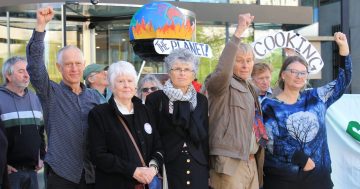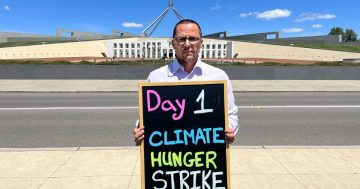
It was a thrilling, energised day. There was no violence, no arrests, protesters even took home their own garbage. Photo: George Tsotsos.
The climate change march on Friday attracted large numbers of protestors, but what is its lasting impact? Kirsten Duncan argues that the march will empower a generation at critical risk. David Murtagh says while well-intentioned, the protests are largely misdirected and it’s an exercise in manipulation.
On Friday my teenage daughter and I joined hundreds of thousands of school and uni students, workers, families, teachers, retailers, tradespeople, health professionals and everyone in between at one of more than 100 protests around Australia as part of the Global Climate Strike.
It was a thrilling, energised day. There was no violence, no arrests, protesters even took home their own garbage. And it was all organised by our children.
They faced down absurd and patronising comments by laggard politicians and vested-interest media that they should be in school getting an education. As many hand-painted signs pointed out, what’s the point of getting an education if our so-called leaders won’t listen to educated scientists and concerned professionals?
As the dust of our global gatherings settles and our endorphins and adrenalin dissipate, many participants might be wondering if the biggest global protest in history will make any difference.
I believe this protest is different. This coordinated action was led using social networking tools that did not exist even a decade ago. More than 2800 Australian companies led by Future Super pledged to conduct ‘not business as usual’, many of them forgoing a day of revenue to allow employees to attend the strike.
This broad coalition of strange bedfellows signals widespread dissatisfaction with the status quo and applies pressure on all aspects of government and corporate business from all directions of society and economy.
Each of the three global strikes over the past year has been bigger than the previous – this is a movement that is gathering momentum and expanding in scale, not fizzling out as objectors surely hoped.
Meaningful social change is messy, complex, contextual and contested, slow and unpredictable. It is not won by simple linear cause-and-effect actions but by the gradual chipping away of resistance, the building of new solutions and pathways until the critical mass of all those efforts combined becomes an irresistible landslide.
We are at a critical juncture. Fifty years ago when global warming was first recognised, it was a vague and distant threat with plenty of time to rectify it. Even five years ago scientists were largely talking in terms of consequences in 2100 and beyond.
But, what feels like suddenly, it has become a single decade, and 10 years is a period of time that even election-cycle-focused politicians can start to relate to.
Opponents will probably opine that the global climate strike was a stupid, naïve, empty gesture, ‘virtue signalling’ at best, a costly disruption at worst. But what those commentators don’t see is the growth of ‘power within’, ‘power with’ and ‘power to’ that the massive gatherings represent. This is best illustrated by a tiny 10-year-old girl in the Canberra march.
Carrying a hand-painted, politically satirical cardboard sign taller than she was, she raised her small voice, calling ‘what do we want?’, ‘when do we want it?’ while the crowd around her enthusiastically responded ‘climate action’, ‘now’.
That child will carry away a sense of personal empowerment and agency. She will share the experience of her practical lesson in democracy with her teachers and classmates and maybe inspire them to take positive action.
I agree with Swedish activist Greta Thunberg that more than hope, we need action. But she’s wrong about nobody doing anything. Certainly, we need far more action, but the scale of the strike has shown that there are rapidly increasing numbers of people who, in the words of the Lorax, care ‘a whole awful lot’, and I take optimism from that.
Kirsten Duncan is completing a Master of Climate Change at the ANU, with a focus on communication and social transformation.





















